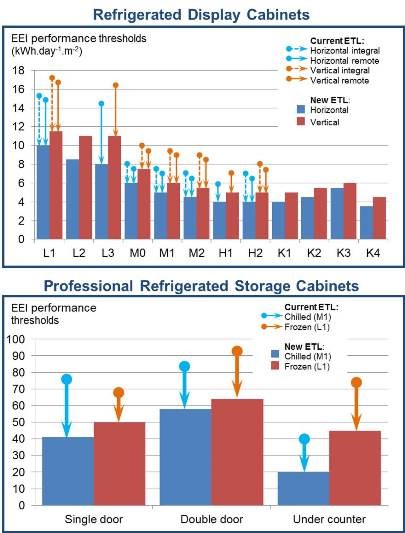New thresholds for commercial and professional ETL cabinets

Work has been ongoing recently to update the criteria for Refrigerated Display Cabinets and Professional Refrigerated Storage Cabinets listed on the Energy Technology List (ETL). These changes will be applied from 1 April 2019 applications using the ‘old’ criteria will stop being processed from 18 February 2019. The ETL lists energy efficient products and is a means for end users to identify best performing products. End users purchasing products listed on the ETL can currently claim an enhanced capital allowance (ECA). However, it was announced in the 2018 budget that the ECA and First Year Tax Credits (FYTC) Scheme for energy saving technologies will end from April 2020. The ETL will still remain and still provide a mechanism to identify the most energy efficient products.
Refrigerated Display Cabinets
The major changes in the revised specification are:
- Two new categories of cabinet are added: water loop cabinets (where the condenser is cooled by a water circuit) and chilled air cabinets (where a central system supplies air to the cabinet). The test method for water cooled cabinets adopts methods already available within BS EN ISO 23953-1:2015. A test method for chilled air cabinets is under development and will be published at https://www.rdandt.co.uk/news/aircooled.
- Beverage coolers (which were always part of the ETL) will now be tested to BS EN 16902:2016 rather than BS EN ISO 23953-1: 2005 +A1:2012.
- All other RDC cabinets will now be tested to BS EN ISO 23953-1:2015.
- Integral and remote cabinets are no longer classified separately.
- An L2 classification for frozen cabinets has been added.
- Changes have been made to the performance thresholds with reductions in the Energy Efficiency Index (EEI) in all existing categories (see figure). In some cases the reductions in EEI are significant (45%) with on average a 33% reduction in EEI.
- For products with glass that have previously been tested to BS EN ISO 23953-2:2005+A1:2012; performance data will only be accepted if the Total Display Area (TDA) is recalculated in accordance with BS EN ISO 23953-2:2015.
- For remote cabinets with refrigerants with glide the evaporating temperature shall be the mid-point temperature between bubble and dew points.
- The criteria now clearly list the verification methods (these were listed previously in another document). Verification methods are in-house testing (self-tested and verified or cross-checked by an independent body), witnessed testing, independent testing.
- For representative testing, any model that complies with the representative cabinet rules and is ±50% of the representative model length will be accepted.
- Future requirements will be aligned with eco-design and labelling regulations with the aim that the ETL will encompass the upper quartile of products on the market.
Professional Refrigerated Storage Cabinets
The major changes in the revised specification are:
- Products with a gross internal volume of between 68 and 1,495 litres are now accepted (rather than previous specified values ±15%).
- Performance threshold categories are now based on height of the cabinet rather than gross internal volume.
- EEI performance thresholds have been reduced as shown in the figure above. Reductions in the EEI average 38%, with some as high as 50%.
- Verification methods are clearly identified and are the same as those for refrigerated display cabinets.
For further information on these ETL changes and how to list cabinets please contact Judith Evans (j.a.evans@rdandt.co.uk) or Alan Foster (alan.foster@rdandt.co.uk) at RD&T.